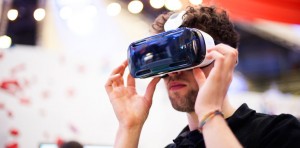VR, too soon for journalism?
Last month, for the very first time in history, people in the United States were able to follow a presidential debate through Virtual Reality (VR). Together with NextVR, CNN offered the service to viewers and promised them an experience wherein they could get to feel like an actual member in the audience (CNN.com). Because of this year’s upcoming releases of VR devices, different industries try to fit in VR in all kinds of media. Not just the gaming industry, but in the example above they want to include VR in a news event. People are able to virtually experience in real-time what is happening at another place. But does VR really contributes to this kind of journalism or is this step taken too soon? Can VR already replace the television for journalism?
Virtual Reality
Virtual reality technologies create a visual representation of a world next to the “real world” (Hayles 14). The first industry to really adapt the technology is the gaming industry, because in most game developments there’s a need to more realism (Pierce). VR devices could take gaming to the next level, because people would experience more that they are taking part of a virtual world. This concept is called immersion (Jennet et al. 641). But does this immersiveness that fits in gaming really needs to be in journalism? Journalism is the practice of gathering stories and frame it to present it to an audience (Deuze 445). News on television is edited to bring manageable news items to the public. It provides a perspective to certain events. CNN wanted to be the first to embed that technology into news distribution and to let the people feel that they were really at the place of the debate through a VR device.
Can VR replace the television for journalism?
The VR event from CNN didn’t go as smoothly as they promised (Lederman). Besides the start-up problems of this new technology, like overheated devices, error pop-ups and broken live streams, it is still the question if VR is really contributing to news sharing and will change the way people want to absorb news events. The way CNN had arranged their VR experience is not that innovative. Instead of using 360-degrees cameras whereby participants could really look around themselves, like in the physical world, they provided four different viewpoints with wide-angle-lenses. People could see the candidates through different viewpoints. This way it’s not that realistic and it’s not more than a television where you can switch through different channels.

Another problem with having VR goggles instead of a television, is that the VR device took away the ability to write or read Tweets about the elections that were taking place, live-tweeting (McKinney, Houston, and Hawthorne 1). You had to remove the VR goggles from your head to check on a mobile phone or laptop what the real time comments are (Lederman). When looking at a Television screen you’re able to multitask these kind of acts and with this implementation of VR it is a downgrade to just look at the display of your VR goggle. It does not make the virtual world more real. So where VR would like to erase limits for people between the physical world and the virtual world, it still really limits people. You have to put the device on and off to really function the way you wanted to do.
People who participated in the VR experience of CNN stated that they couldn’t see the faces of the candidates that were talking. The participants got overview sights, couldn’t zoom in and have blurry views of the people in the virtual world. Television however provides multiple angles and frames a story for the public to let them easily watch it and let them focus on certain aspects. This brings us to the question if we really want to be that audience to watch news events real-time by ourselves. Don’t we just like to view the shots that directors are arranging for us? The subjectivity of journalism will be gone while this is one of the biggest characteristics of the news.
CNN has taken the first step in involving VR into news distribution, but this step was not the one that really contributes to a new way of experiencing the news. At this point journalism isn’t ready for VR. To be virtually present at a news event and experience in real-time what is happening, isn’t really necessary. This reality is a piece of mess that needs to be constructed. People still need framing and CNN didn’t cover this aspect with their VR experiment. VR is too soon for journalism.
Bibliography
Deuze, Mark. “What Is Journalism?” Journalism 6.4 (Nov. 2005): 442–464. 29 Oct. 2015. <http://jou.sagepub.com/content/6/4/442.short>.
Hayles, Katherine N. “Virtual Bodies and Flickering Signifiers.” October (Jan. 1993): 69–91. 30 Oct. 2015. <http://www.jstor.org/stable/778755?seq=1#page_scan_tab_contents >.